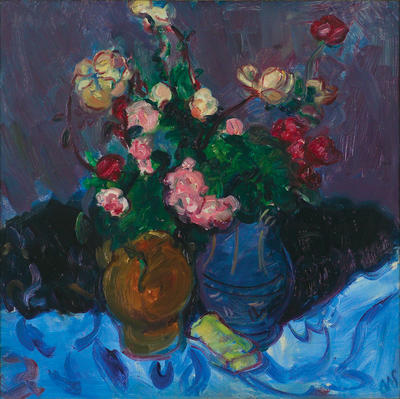Mixed Roses in Two Jugs
Artist and role
Smith, Matthew (British, b.1879, d.1959), Artist
Date
1929
See full details
About this work
Smith has chosen a common theme for his still life – a vase of flowers – only he has chosen to put his unruly roses in two jugs rather than one. A graduate from the Slade School in London, he moved to France in 1908 and eventually settled in Paris. His work soon began to show the influence of Fauvism and of Matisse, in whose studio he worked in 1910. His interest in colour was probably stimulated by an upbringing in grim industrial Yorkshire, and his resultant bold complementaries and radiant hues, applied rhythmically to the canvas, reflected the exhilaration colour gave him. Smith worked from traditional subjects throughout his career (the nude, landscape and still life) and the confident and fluid manner in which he painted brought him a certain success. He exhibited regularly in London and featured at the Venice Biennale in 1938 and in 1950.
Mixed Roses in Two Jugs was probably painted around 1935, and one of Smith’s favourite bright blues has been used for a Matisse-like cloth that brings the vases to the front of the picture plane. The vases, in complementary dark blue and orange-brown, are separated by a lemon yellow oblong that energises the painting. The roses, with their confident outlines, push forward against the dull navy of the table and sing against the mauve background. His ability to use paint to create a cohesive whole on the canvas was admired by several 20th-century British artists, including Francis Bacon and Howard Hodgkin. Bacon described Matthew Smith’s use of paint as making ‘a direct assault upon the nervous system’.
Mixed Roses in Two Jugs was probably painted around 1935, and one of Smith’s favourite bright blues has been used for a Matisse-like cloth that brings the vases to the front of the picture plane. The vases, in complementary dark blue and orange-brown, are separated by a lemon yellow oblong that energises the painting. The roses, with their confident outlines, push forward against the dull navy of the table and sing against the mauve background. His ability to use paint to create a cohesive whole on the canvas was admired by several 20th-century British artists, including Francis Bacon and Howard Hodgkin. Bacon described Matthew Smith’s use of paint as making ‘a direct assault upon the nervous system’.
Measurements
590 x 595 mm sight size
Artist
Credit
Collection of the Dunedin Public Art Gallery. Purchased 1947 with funds from the Dunedin Public Art Gallery Society through the National Art Collections Fund, London.
©The Artist's Estate
©The Artist's Estate
Accession number
6-1947


